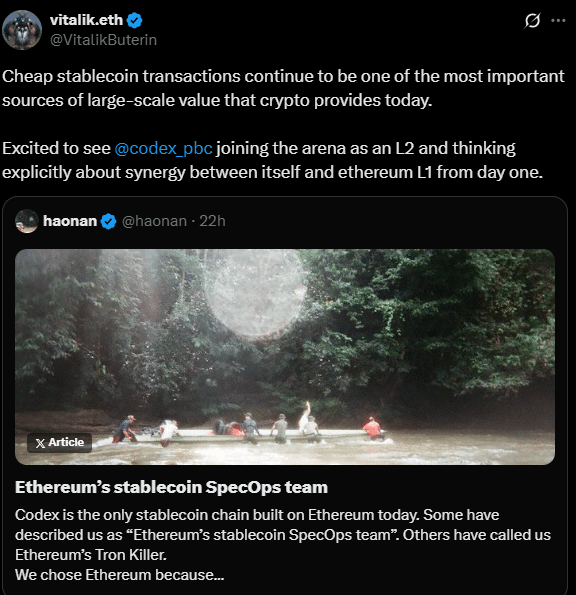Codex is a payments-first Ethereum Layer 2 focused on stablecoins that could re-energize interest in Ethereum L2s by offering native stablecoin rails, tighter Ethereum L1 synergy, and lower settlement friction—but its success depends on adoption, decentralization plans, and regulatory navigation.
-
Codex targets native stablecoin payments on an Ethereum L2 basis
-
Vitalik Buterin publicly endorsed Codex’s L2 approach, highlighting L1–L2 synergy.
-
Experts warn adoption and permissionless transition risks; historical payments trends favor product-market fit over distribution alone.
Primary keyword: Codex Ethereum L2 — Analyze whether Codex can revive Ethereum L2 stablecoin use; read expert views and next steps.
What is Codex and can it revive interest in Ethereum L2s?
Codex Ethereum L2 is a payments-first Layer 2 built to optimize stablecoin rails on top of Ethereum. It aims to reduce friction for high-volume stablecoin payments while preserving L1 security and interoperability with existing Ethereum tooling. Success will hinge on developer adoption, liquidity integration, and regulatory clarity.
How does Codex differ from Stripe’s Tempo and other corporate payment chains?
Codex builds on Ethereum’s permissionless base, emphasizing decentralization and L1 synergy. By contrast, Tempo (Stripe) initially targets a permissioned model with planned later transitions. Codex’s advantage is immediate access to Ethereum’s ecosystem and composability with existing DeFi primitives, while Tempo targets enterprise distribution and control.

Source: X
Why do experts disagree on the outcome?
Views split along two lines: product-led vs distribution-led narratives. Some, like Tom Lee and Christian Catalini, caution that corporate-controlled chains risk centralization and regulatory chokepoints. Others, including VC perspectives from industry veterans, argue payments innovation historically favors product execution over sheer distribution advantages.
Key arguments for Codex:
-
Decentralization and composability: Building on Ethereum L1 allows interoperability with wallets, bridges, and DeFi.
-
Native payments optimization: Codex’s design prioritizes stablecoin flow, settlement times, and payment primitives.
-
Community trust signal: Endorsements from figures like Vitalik Buterin increase developer and community attention.
Key risks and challenges:
-
Adoption hurdle: Matching Stripe, Google or issuer-level distribution requires partnerships and liquidity.
-
Permissionless transition: Corporate-to-public transitions historically face governance and technical friction.
-
Regulatory environment: Stablecoin regulation and KYC/AML requirements could shape architecture decisions and market fit.
When could we see clear indicators of success for Codex?
Measure success by three near-term signals: (1) native stablecoin volume and active payment flows on Codex, (2) integrations with major wallets and custodians, and (3) a credible roadmap toward permissionless governance without centralized chokepoints.
Frequently Asked Questions
Can Codex match Stripe’s merchant distribution?
Not immediately. Stripe’s existing merchant relationships and market reach present a distribution advantage. Codex’s path relies on product-led adoption, DeFi integrations, and partnerships to scale merchant and liquidity usage over time.
Is Codex permissionless from launch?
Codex positions itself as an L2 aligned with Ethereum’s permissionless ethos; however, implementation details on governance and rollout phases matter. Transition plans and on-chain governance will determine how permissionless it becomes.
Key Takeaways
- Codex is focused: Payments-first L2 targeting stablecoin rails on Ethereum.
- Endorsement matters: Public support from Ethereum co-founder Vitalik Buterin adds credibility.
- Outcome depends on execution: Adoption, decentralization path, and regulatory clarity will decide whether Codex revives L2 stablecoin momentum.
Conclusion
Codex presents a compelling technical approach to native stablecoin payments on an Ethereum L2 and has drawn notable endorsements. Yet its ability to revive broader interest in Ethereum L2s will depend on measurable adoption, integration with wallets and liquidity providers, and a credible path to permissionless governance. Watch for volume, integrations, and governance milestones as the next indicators of market traction.
